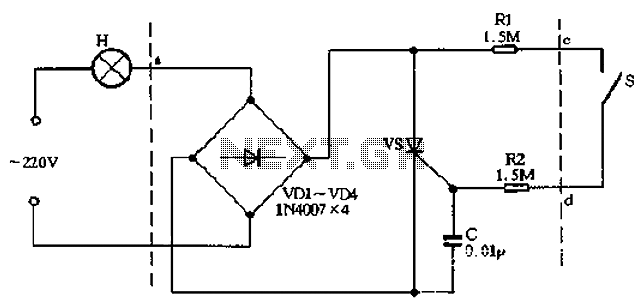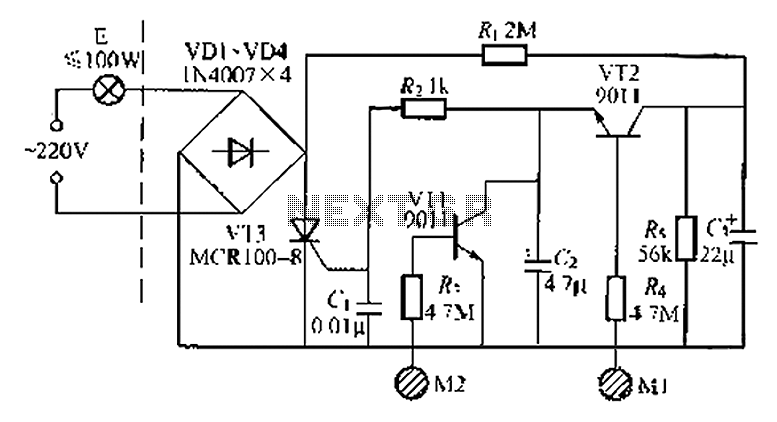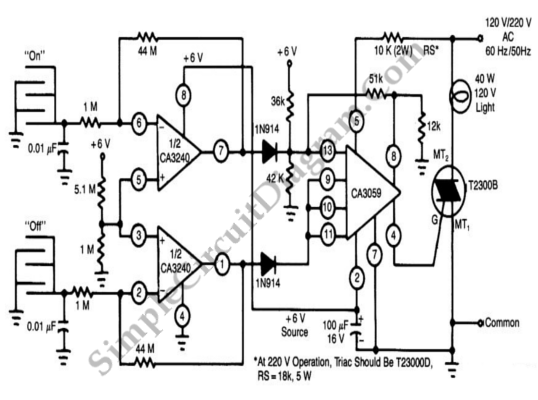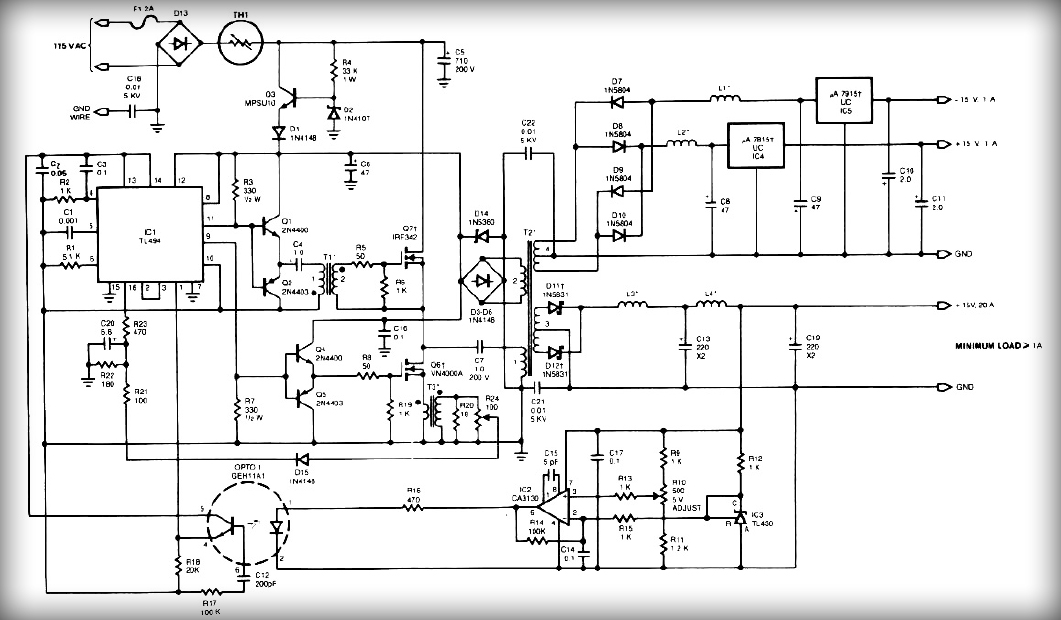
Safe bedside lamp lighting switch

Closing the switch S allows the SCR to be triggered through resistors R1 and R2, which results in the lamp being powered by full-wave AC voltage. When the switch S is opened, the gate trigger current is lost, and the lamp turns off at the AC zero crossing. This operation is similar to that of a standard bedside lamp switch. The bedside lamp switch S is connected to the electric cord with high-value resistors R1 and R2 for isolation. This design ensures that even if the power cord is damaged or if a child bites the switch lead wire insulation, there will be no risk of electric shock.
The described circuit functions as a safety switch for a bedside lamp, utilizing a Silicon Controlled Rectifier (SCR) for effective control of the lamp's operation. Upon closing switch S, the SCR is activated through the resistors R1 and R2, allowing current to flow and powering the lamp with full-wave alternating current (AC). The SCR remains in the conducting state until the gate trigger current is interrupted, which occurs when switch S is opened. At this moment, the AC voltage reaches zero, causing the SCR to turn off and the lamp to extinguish.
The implementation of high-value resistors R1 and R2 serves a dual purpose: they provide the necessary gate trigger current to the SCR while also acting as a safety isolation mechanism. This isolation is crucial, as it minimizes the risk of electric shock in case of accidental damage to the power cord or other components. In scenarios where the insulation is compromised, such as children biting the wires, the high resistance ensures that insufficient current flows to pose a threat, effectively safeguarding users from potential hazards.
In summary, this circuit design not only allows for the convenient operation of a bedside lamp but also incorporates essential safety features that protect against electrical accidents, making it suitable for use in environments where children may be present. Closing the switch S. SCR vs through resistors R1, R2 and S trigger current and get opened, charged with H lamp that is eligible for the full-wave AC normal light; open the swi tch S. vs loses gate trigger current, when the AC zero crossing that is turned off, the lights go out. So turn off the lights and turn on the lights and ordinary bedside lamp switch is no different. But the connection bedside lamp switch S electric cord string with a high value resistor Rl and R2 isolation, even if the power cord is broken even children nibbled switch lead wire insulation foreskin, or switch into the mouth, will not cause electric shock.
The described circuit functions as a safety switch for a bedside lamp, utilizing a Silicon Controlled Rectifier (SCR) for effective control of the lamp's operation. Upon closing switch S, the SCR is activated through the resistors R1 and R2, allowing current to flow and powering the lamp with full-wave alternating current (AC). The SCR remains in the conducting state until the gate trigger current is interrupted, which occurs when switch S is opened. At this moment, the AC voltage reaches zero, causing the SCR to turn off and the lamp to extinguish.
The implementation of high-value resistors R1 and R2 serves a dual purpose: they provide the necessary gate trigger current to the SCR while also acting as a safety isolation mechanism. This isolation is crucial, as it minimizes the risk of electric shock in case of accidental damage to the power cord or other components. In scenarios where the insulation is compromised, such as children biting the wires, the high resistance ensures that insufficient current flows to pose a threat, effectively safeguarding users from potential hazards.
In summary, this circuit design not only allows for the convenient operation of a bedside lamp but also incorporates essential safety features that protect against electrical accidents, making it suitable for use in environments where children may be present. Closing the switch S. SCR vs through resistors R1, R2 and S trigger current and get opened, charged with H lamp that is eligible for the full-wave AC normal light; open the swi tch S. vs loses gate trigger current, when the AC zero crossing that is turned off, the lights go out. So turn off the lights and turn on the lights and ordinary bedside lamp switch is no different. But the connection bedside lamp switch S electric cord string with a high value resistor Rl and R2 isolation, even if the power cord is broken even children nibbled switch lead wire insulation foreskin, or switch into the mouth, will not cause electric shock.





